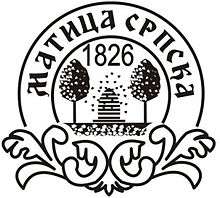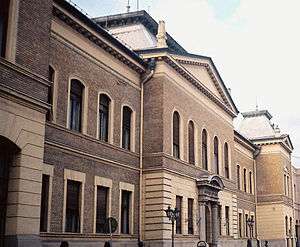Matica srpska
 Logo | |
| Formation | 1 June 1826 |
|---|---|
| Purpose | Cultural studies |
| Headquarters | Novi Sad, Serbia |
| Website | www.maticasrpska.org.rs |
The Matica srpska (Serbian Cyrillic: Матица српска)[1] is the oldest cultural-scientific institution of Serbia. Matica Srpska was founded in 1826, in Pest (today a part of Budapest),[2] and moved to Novi Sad in 1864.[2]

History
Of all the Slavic maticas, Matica Srpska was the first to be established in the Habsburg Empire on the ancestral territory of the Rascians (better known as Rascia) at the time of a Serb national and cultural awakening, while under Habsburg and Ottoman thralldom.[3]
In the national awakening, the Serbs of the Serbian Vojvodina played an instrumental role as, by force of historical circumstance, they formed at this period the core of Serb intellectual life. One of the most important tasks facing the Serbs, in advancing cultural-national rebirth, was the solution of the literary language problem, and, as a result of the first fifty years of the 19th century, saw the Vojvodina Serbs engaged in an intense debate about the kind of literary language that their newly revitalized, emerging nation should adopt.
For the Slavic people, as well as the non-Slavs, under the Habsburg Empire, the Matica foundation fomented the development of national cultures. Indeed, the oldest is Matica srpska founded in 1826 in Pest by Jovan Hadžić and his business backers, Josif Milovuk (1793-1850), Jovan Demetrović (1778-1830), Gavrilo Bozitovac (1789-1856), Andrija Rozmirović, Petar Rajić, and Djordje Stanković (1782-1853) at the same time as the Hungarian Academy was being built. Jovan Hadžić prepared its by-laws, secured its charter, and also served as its first president while Josif Milovuk served as its first secretary. In addition to books, it published the journal Serbski letopis, founded two years earlier by Georgije Magarašević, Pavel Jozef Šafárik, and Lukijan Mušicki in Novi Sad, where Magaraševic was professor and Šafárik the director of Novi Sad's Serbian Gymnasium.
The story of the Matica Srpska actually began in 1824,[2] when the Austrian authorities permitted writer Georgije Magarašević, a professor at a gymnasium in the town of Novi Sad, to publish a literary and scholarly journal entitled "Serbski letopis" (Serbian Annals).[2] Magarašević had little financial backing but soon found benefactors who supported his efforts, and in time, somehow the writers and editors of the publication developed into a learned society. It has also been the most lasting, for the society successfully overcame the pressures applied by mistrustful Austrian officials as well as later financial difficulties. With varying degrees of success but with great perseverance, it has continued to support and guide Serb intellectual endeavor, first as a part of the Habsburg Empire and much later in Serbia.
In 1838, the wealthy Serb landowner Sava Tekelija left the Matica a legacy to support Serbian students at the University of Pest and a college named after him, Tekelijanum (Tokolyanum in Hungarian). The Hungarian authorities were suspicious of the Matica and even suspended its activities in 1835–1836 for alleged pan-Slavism, but they resisted Serb efforts to move the institution to Novi Sad. In 1863 the move was nevertheless accomplished, and the Matica, as well as the journal Letopis, is flourishing there today.
The Matica Srpska Society was one of the initiators of the Novi Sad agreement on the Serbo-Croatian language (1954), and it led the action for making the unique orthography of the language (1960). They compiled The Vocabulary of Serbian Standard Literary Language in six volumes (1967–1976).
In Yugoslavia, Matica srpska was one half of a joint project (with Matica hrvatska) to develop a common Serbo-Croatian dictionary. Mid-way through the project (1967), Matica hrvatska, in accordance with the declaration of principles about the Croatian language, withdrew, and Matica srpska was left to finish the dictionary on her own.
Matica Srpska has been an example to many Slavic nations. Based on this model the following institutions were established: Czech Matica in 1831, Illyrian Matica in 1842 (in 1874 renamed to Matica Hrvatska); Matica Lužičkosrpska in 1847, Halych-Russian Matica in Lviv in 1848; Moravian Matica in 1849; Matica Dalmatinska in Zadar in 1861; Slovak Matica in 1863; Slovenian Matica in 1864; Matica Opava in 1877; Matica in the Teschen Princedom in 1898. (from which Silesian Matica came to be in 1968); Polish Matica in Lvov (1882); Educational Matica in the Teschen Princedom in 1885; Educational Matica in Warsaw in 1905; Bulgarian Matica in Constantinople in 1909 and the new Bulgarian Matica in 1989.
Activities and library
Matica Srpska publishes the Letopis Matice srpske magazine, which is one of the oldest in the world,[2] being continuously published since 1824.
The Law of the Matica Srpska Society (1986) regulates matters of endowment and legacy, given by the national benefactors, and how money is spent for various cultural and educational purposes.
The Matica Srpska has a library with over 3,500,000 books and other documents.[2]
Editors of Letopis Matice srpske since 1824
- Georgije Magarašević (1824–1830), man of letters, founder, publisher and editor, before and after it was incorporated as an official organ of the Matica srpska in 1825/1826
- Jovan Hadžić (1830–1831),
- Pavle Stamatović (1831–1832),
- Teodor Pavlović (1832–1841),
- Jovan Subotić (1841–1848),
- Sima Filipović (1848),
- Jovan Subotić (1850–1853),
- Jakov Ignjatović (1854–1856),
- Jovan Mladenović-Subota (1856–1857),
- Jovan Đorđević (1857–1859),
- Antonije Hadžić (1859–1871),
- Jovan Bošković (1871–1875),
- Antonije Hadžić (1876–1895),
- Milan Savić (1896–1911),
- Tihomir Ostojić (1912–1914),
- Vasa Stajić (1921),
- Kamenko Subotić (1922–1923),
- Marko Maletin (1923–1929),
- Stevan Ćirić (1929),
- Svetislav Banica (1929),
- Radivoje Vrhovac (1930),
- Todor Manojlović (1931),
- Žarko Vasiljević (1932),
- Nikola Milutinović (1933–1935),
- Vasa Stajić (1936), pedagogue
- Nikola Milutinović (1936–1941),
- Živan Milisavac (1946–1957),
- Mladen Leskovac (1958–1964),
- Boško Petrović (1964–1969),
- Aleksandar Tišma (1969–1973), novelist
- Dimitrije Vučenov (1974–1979),
- Momčilo Milankov (1979),
- Boško Ivkov (1980–1991),
- Slavko Gordić (1992–2008),
- Ivan Negrišorac (2008–present) is the nom de plume of poet Dragan Stanić
See also
References
- ↑ The name in Serbia, as "Матица српска" formats only the first word to have a capital letter, as also the style in Italian titles or operas. For the name in English, each word can have a capital letter, as customary for English titles.
- 1 2 3 4 5 6 "MATICA SRPSKA", maticasrpska.org.rs, 2013. Retrieved 2013-05-31.
- ↑ Srbi u Vojvodini, Том 2 by Dušan J. Popović, Matica srpska, 1990, p. 3
External links
| Wikimedia Commons has media related to Matica srpska. |